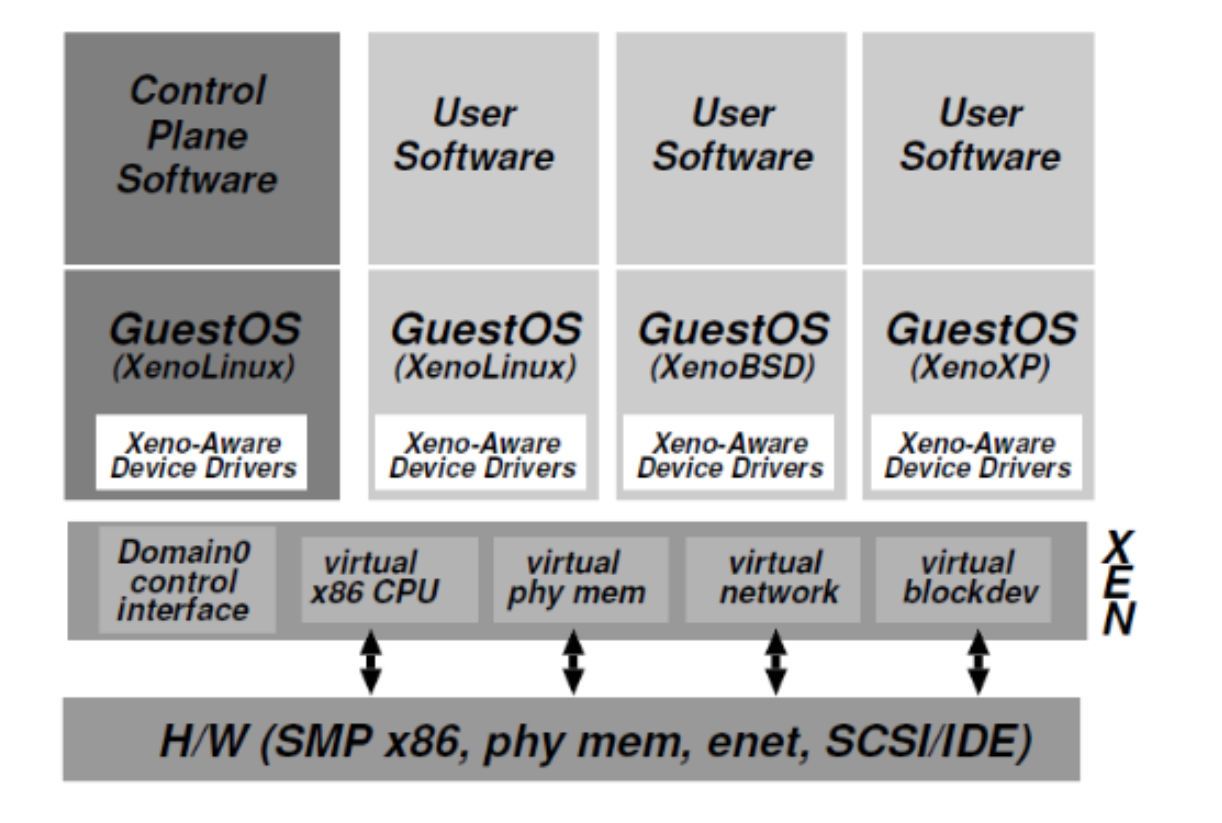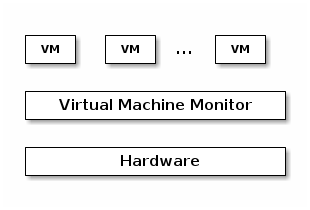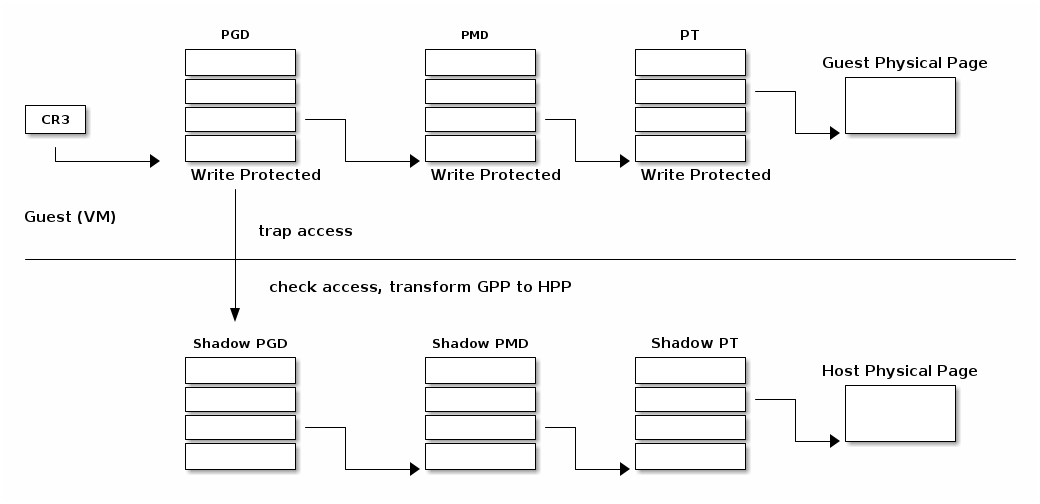Virtualization¶
Lecture objectives:¶
- Emulation basics
- Virtualization basics
- Paravirtualization basics
- Hardware support for virtualization
- Overview of the Xen hypervisor
- Overview of the KVM hypervisor
Emulation basics¶
- Instructions are emulated (each time they are executed)
- The other system components are also emulated:
- MMU
- Physical memory access
- Peripherals
- Target architecture - the architecture that it is emulated
- Host architecture - the architecture that the emulator runs on
- For emulation target and host architectures can be different
Classic virtualization¶
- Trap & Emulate
- Same architecture for host and target
- Most of the target instructions are natively executed
- Target OS runs in non-privilege mode on the host
- Privileged instructions are trapped and emulated
- Two machine states: host and guest
Software virtualization¶
- Not all architecture can be virtualized; e.g. x86:
- CS register encodes the CPL
- Some instructions don't generate a trap (e.g. popf)
- Solution: emulate instructions using binary translation
MMU virtualization¶
- "Fake" VM physical addresses are translated by the host to actual physical addresses
- Guest virtual address -> Guest physical address -> Host Physical Address
- The guest page tables are not directly used by the host hardware
- VM page tables are verified then translated into a new set of page tables on the host (shadow page tables)
Lazy shadow sync¶
- Guest page tables changes are typically batched
- To avoid repeated traps, checks and transformations map guest page table entries with write access
- Update the shadow page table when
- The TLB is flushed
- In the host page fault handler
I/O emulation¶
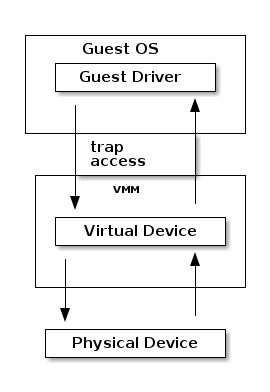
/*
* QEMU model of the UART on the SiFive E300 and U500 series SOCs.
*
* Copyright (c) 2016 Stefan O'Rear
*
* This program is free software; you can redistribute it and/or modify it
* under the terms and conditions of the GNU General Public License,
* version 2 or later, as published by the Free Software Foundation.
*
* This program is distributed in the hope it will be useful, but WITHOUT
* ANY WARRANTY; without even the implied warranty of MERCHANTABILITY or
* FITNESS FOR A PARTICULAR PURPOSE. See the GNU General Public License for
* more details.
*
* You should have received a copy of the GNU General Public License along with
* this program. If not, see <http://www.gnu.org/licenses/>.
*/
#include "qemu/osdep.h"
#include "qapi/error.h"
#include "qemu/log.h"
#include "chardev/char.h"
#include "chardev/char-fe.h"
#include "hw/irq.h"
#include "hw/char/sifive_uart.h"
/*
* Not yet implemented:
*
* Transmit FIFO using "qemu/fifo8.h"
*/
/* Returns the state of the IP (interrupt pending) register */
static uint64_t uart_ip(SiFiveUARTState *s)
{
uint64_t ret = 0;
uint64_t txcnt = SIFIVE_UART_GET_TXCNT(s->txctrl);
uint64_t rxcnt = SIFIVE_UART_GET_RXCNT(s->rxctrl);
if (txcnt != 0) {
ret |= SIFIVE_UART_IP_TXWM;
}
if (s->rx_fifo_len > rxcnt) {
ret |= SIFIVE_UART_IP_RXWM;
}
return ret;
}
static void update_irq(SiFiveUARTState *s)
{
int cond = 0;
if ((s->ie & SIFIVE_UART_IE_TXWM) ||
((s->ie & SIFIVE_UART_IE_RXWM) && s->rx_fifo_len)) {
cond = 1;
}
if (cond) {
qemu_irq_raise(s->irq);
} else {
qemu_irq_lower(s->irq);
}
}
static uint64_t
uart_read(void *opaque, hwaddr addr, unsigned int size)
{
SiFiveUARTState *s = opaque;
unsigned char r;
switch (addr) {
case SIFIVE_UART_RXFIFO:
if (s->rx_fifo_len) {
r = s->rx_fifo[0];
memmove(s->rx_fifo, s->rx_fifo + 1, s->rx_fifo_len - 1);
s->rx_fifo_len--;
qemu_chr_fe_accept_input(&s->chr);
update_irq(s);
return r;
}
return 0x80000000;
case SIFIVE_UART_TXFIFO:
return 0; /* Should check tx fifo */
case SIFIVE_UART_IE:
return s->ie;
case SIFIVE_UART_IP:
return uart_ip(s);
case SIFIVE_UART_TXCTRL:
return s->txctrl;
case SIFIVE_UART_RXCTRL:
return s->rxctrl;
case SIFIVE_UART_DIV:
return s->div;
}
qemu_log_mask(LOG_GUEST_ERROR, "%s: bad read: addr=0x%x\n",
__func__, (int)addr);
return 0;
}
static void
uart_write(void *opaque, hwaddr addr,
uint64_t val64, unsigned int size)
{
SiFiveUARTState *s = opaque;
uint32_t value = val64;
unsigned char ch = value;
switch (addr) {
case SIFIVE_UART_TXFIFO:
qemu_chr_fe_write(&s->chr, &ch, 1);
update_irq(s);
return;
case SIFIVE_UART_IE:
s->ie = val64;
update_irq(s);
return;
case SIFIVE_UART_TXCTRL:
s->txctrl = val64;
return;
case SIFIVE_UART_RXCTRL:
s->rxctrl = val64;
return;
case SIFIVE_UART_DIV:
s->div = val64;
return;
}
qemu_log_mask(LOG_GUEST_ERROR, "%s: bad write: addr=0x%x v=0x%x\n",
__func__, (int)addr, (int)value);
}
static const MemoryRegionOps uart_ops = {
.read = uart_read,
.write = uart_write,
.endianness = DEVICE_NATIVE_ENDIAN,
.valid = {
.min_access_size = 4,
.max_access_size = 4
}
};
static void uart_rx(void *opaque, const uint8_t *buf, int size)
{
SiFiveUARTState *s = opaque;
/* Got a byte. */
if (s->rx_fifo_len >= sizeof(s->rx_fifo)) {
printf("WARNING: UART dropped char.\n");
return;
}
s->rx_fifo[s->rx_fifo_len++] = *buf;
update_irq(s);
}
static int uart_can_rx(void *opaque)
{
SiFiveUARTState *s = opaque;
return s->rx_fifo_len < sizeof(s->rx_fifo);
}
static void uart_event(void *opaque, QEMUChrEvent event)
{
}
static int uart_be_change(void *opaque)
{
SiFiveUARTState *s = opaque;
qemu_chr_fe_set_handlers(&s->chr, uart_can_rx, uart_rx, uart_event,
uart_be_change, s, NULL, true);
return 0;
}
/*
* Create UART device.
*/
SiFiveUARTState *sifive_uart_create(MemoryRegion *address_space, hwaddr base,
Chardev *chr, qemu_irq irq)
{
SiFiveUARTState *s = g_malloc0(sizeof(SiFiveUARTState));
s->irq = irq;
qemu_chr_fe_init(&s->chr, chr, &error_abort);
qemu_chr_fe_set_handlers(&s->chr, uart_can_rx, uart_rx, uart_event,
uart_be_change, s, NULL, true);
memory_region_init_io(&s->mmio, NULL, &uart_ops, s,
TYPE_SIFIVE_UART, SIFIVE_UART_MAX);
memory_region_add_subregion(address_space, base, &s->mmio);
return s;
}
Paravirtualization¶
- Change the guest OS so that it cooperates with the VMM
- CPU paravirtualization
- MMU paravirtualization
- I/O paravirtualization
- VMM exposes hypercalls for:
- activate / deactivate the interrupts
- changing page tables
- accessing virtualized peripherals
- VMM uses events to trigger interrupts in the VM
Intel VT-x¶
- Hardware extension to transform x86 to the point it can be virtualized "classically"
- New execution mode: non-root mode
- Each non-root mode instance uses a Virtual Machine Control Structure (VMCS) to store its state
- VMM runs in root mode
- VM-entry and VM-exit are used to transition between the two modes
Virtual Machine Control Structure¶
- Guest information: state of the virtual CPU
- Host information: state of the physical CPU
- Saved information:
- visible state: segment registers, CR3, IDTR, etc.
- internal state
- VMCS can not be accessed directly but certain information can be accessed with special instructions
VM entry & exit¶
- VM entry - new instructions that switches the CPU in non-root mode and loads the VM state from a VMCS; host state is saved in VMCS
- Allows injecting interrupts and exceptions in the guest
- VM exit will be automatically triggered based on the VMCS configuration
- When VM exit occurs host state is loaded from VMCS, guest state is saved in VMCS
VM execution control fields¶
- Selects conditions which triggers a VM exit; examples:
- If an external interrupt is generated
- If an external interrupt is generated and EFLAGS.IF is set
- If CR0-CR4 registers are modified
- Exception bitmap - selects which exceptions will generate a VM exit
- IO bitmap - selects which I/O addresses (IN/OUT accesses) generates a VM exit
- MSR bitmaps - selects which RDMSR or WRMSR instructions will generate a VM exit
Extend Page Tables¶
- Reduces the complexity of MMU virtualization and improves performance
- Access to CR3, INVLPG and page faults do not require VM exit anymore
- The EPT page table is controlled by the VMM

VPID¶
- VM entry and VM exit forces a TLB flush - loses VMM / VM translations
- To avoid this issue a VPID (Virtual Processor ID) tag is associated with each VM (VPID 0 is reserved for the VMM)
- All TLB entries are tagged
- At VM entry and exit just the entries associated with the tags are flushed
- When searching the TLB just the current VPID is used
I/O virtualization¶
- Direct access to hardware from a VM - in a controlled fashion
- Map the MMIO host directly to the guest
- Forward interrupts

Instead of trapping MMIO as with emulated devices we can allow the guest to access the MMIO directly by mapping through its page tables.
Interrupts from the device are handled by the host kernel and a signal is send to the VMM which injects the interrupt to the guest just as for the emulated devices.
VT-d protects and translates VM physical addresses using an I/O MMU (DMA remaping)
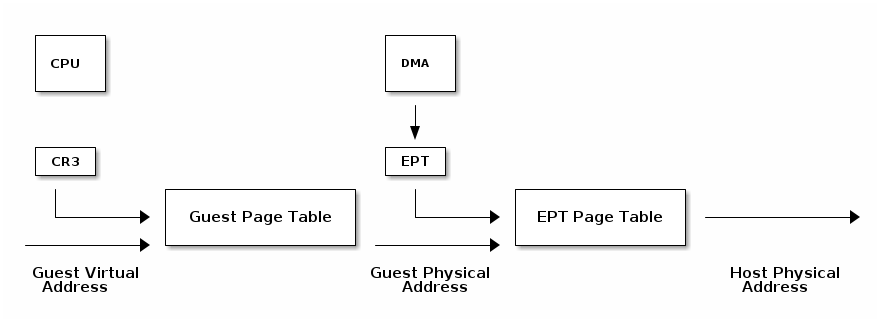
- Messsage Signaled Interrupts (MSI) = DMA writes to the host address range of the IRQ controller (e.g. 0xFEExxxxx)
- Low bits of the address and the data indicate which interrupt vector to deliver to which CPU
- Interrupt remapping table points to the virtual CPU (VMCS) that should receive the interrupt
- I/O MMU will trap the IRQ controller write and look it up in the
interrupt remmaping table
- if that virtual CPU is currently running it will take the interrupt directly
- otherwise a bit is set in a table (Posted Interrupt Descriptor table) and the interrupt will be inject next time that vCPU is run
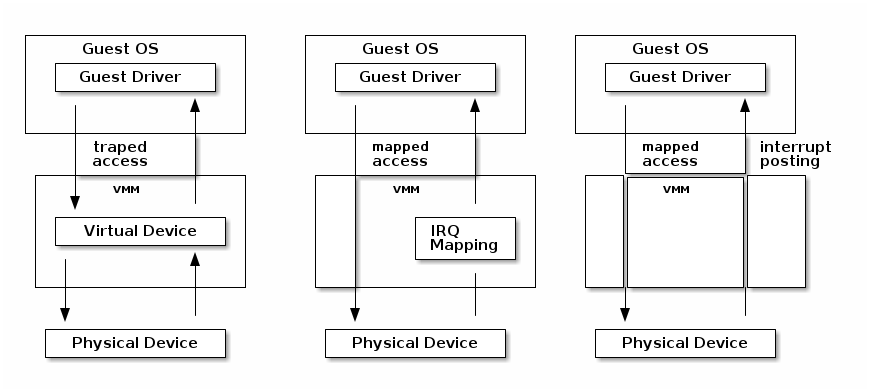
- Single Root - Input Output Virtualization
- Physical device with multiple Ethernet ports will be shown as multiple device on the PCI bus
- Physical Function is used for the control and can be configured
- to present itself as a new PCI device
- which VLAN to use
- The new virtual function is enumerated on the bus and can be assigned to a particular guest
qemu¶
- Uses binary translation via Tiny Code Generator (TCG) for efficient emulation
- Supports different target and host architectures (e.g. running ARM VMs on x86)
- Both process and full system level emulation
- MMU emulation
- I/O emulation
- Can be used with KVM for accelerated virtualization
KVM¶
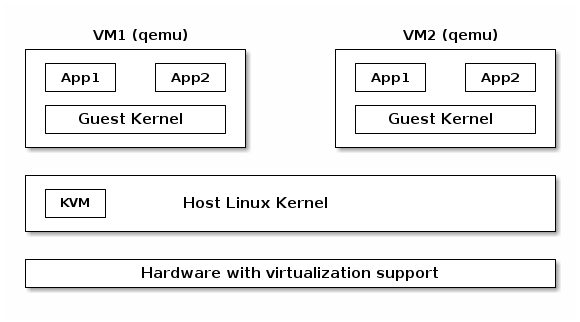
- Linux device driver for hardware virtualization (e.g. Intel VT-x, SVM)
- IOCTL based interface for managing and running virtual CPUs
- VMM components implemented inside the Linux kernel (e.g. interrupt controller, timers)
- Shadow page tables or EPT if present
- Uses qemu or virtio for I/O virtualization
Type 1 vs Type 2 Hypervisors¶
- Type 1 = Bare Metal Hypervisor
- Type 2 = Hypervisor embedded in an exist kernel / OS
Xen¶
